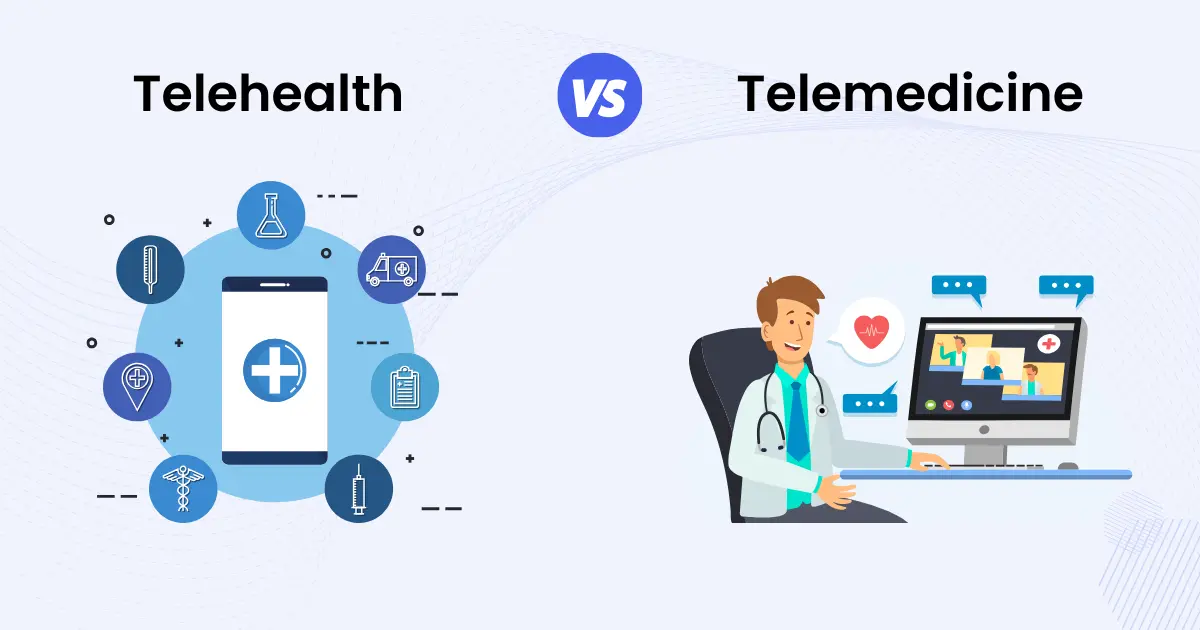Table of Contents
- Telehealth Vs Telemedicine: Meanings
- What is Telehealth?
- Key Features of Telehealth:
- What is Telemedicine?
- Key Features of Telemedicine:
- Telehealth Vs Telemedicine: Key Differences
- Telehealth vs Telemedicine: Examples
- Telehealth Vs Telemedicine: Benefits
- Convenience
- Increased Access
- Cost-Effectiveness
- Improved Patient Engagement
- Solutions Offered by vDoctor
- Conclusion
Understanding the differences between telehealth and telemedicine is becoming increasingly important in today’s healthcare landscape. With the rapid advancement of technology and the growing need for accessible healthcare services, these terms often get used interchangeably. However, they represent distinct concepts that play unique roles in enhancing patient care. In this article, we’ll explore the nuances of telehealth vs. telemedicine, their benefits, and how solutions like vDoctor can help bridge gaps in healthcare delivery.
Telehealth Vs Telemedicine: Meanings
What is Telehealth?
Telehealth is a broad term that encompasses a variety of healthcare services delivered remotely through technology. This includes not only clinical services but also non-clinical activities such as health education, administrative meetings, and public health initiatives. Telehealth aims to improve patient outcomes by making healthcare more accessible and efficient.
Key Features of Telehealth:
- Remote Monitoring: Patients can be monitored from home using devices that track vital signs and health metrics.
- Health Education: Telehealth platforms often provide educational resources to help patients manage their conditions.
- Administrative Services: Scheduling appointments and managing patient records can also be conducted online.
- Non-Clinical Services: This includes training for healthcare professionals and public health campaigns.
What is Telemedicine?
Telemedicine, on the other hand, refers specifically to the provision of clinical services over telecommunications technology. It focuses on diagnosing and treating patients remotely, typically through video consultations or remote monitoring tools.
Key Features of Telemedicine:
- Virtual Consultations: Patients can have real-time interactions with healthcare providers via video calls.
- Remote Diagnosis: Physicians can evaluate symptoms and provide treatment recommendations without an in-person visit.
- Prescription Management: Doctors can prescribe medications electronically based on virtual consultations.
- Chronic Disease Management: Telemedicine is particularly beneficial for patients with chronic conditions who require regular monitoring.
Telehealth Vs Telemedicine: Key Differences
While both telehealth and telemedicine utilize technology to enhance healthcare delivery, their scopes differ significantly:
| Feature | Telehealth | Telemedicine |
|---|---|---|
| Definition | A broad range of remote healthcare services | Clinical services delivered remotely |
| Scope | Includes non-clinical services | Focuses solely on medical diagnosis/treatment |
| Examples | Health education, remote monitoring | Virtual doctor visits, prescription management |
| Target Audience | Patients and healthcare providers | Primarily patients seeking medical care |
Telehealth vs Telemedicine: Examples
To illustrate the differences further:
- Telehealth Example: A hospital uses a platform to educate patients about managing diabetes through online workshops and resources.
- Telemedicine Example: A patient consults a doctor via video call to discuss symptoms of an illness and receives a prescription without visiting the clinic.
Telehealth Vs Telemedicine: Benefits
Both telehealth and telemedicine offer numerous advantages that enhance patient care:
Convenience
Patients can access healthcare services from the comfort of their homes, reducing travel time and waiting periods.
Increased Access
These technologies enable individuals in rural or underserved areas to connect with specialists who may not be available locally.
Cost-Effectiveness
Telemedicine visits are often less expensive than traditional in-person appointments, saving both time and money for patients.
Improved Patient Engagement
Patients are more likely to engage in their health management when they can easily access information and communicate with providers remotely.
Solutions Offered by vDoctor
vDoctor provides a comprehensive platform that integrates both telehealth and telemedicine services. Here’s how vDoctor stands out:
- User-Friendly Interface: Patients can easily navigate the platform to schedule appointments or access educational resources.
- Integrated Services: The platform combines clinical consultations with health education, ensuring patients receive holistic care.
- Secure Communication: vDoctor prioritizes patient privacy with secure messaging and video conferencing tools.
Conclusion
In summary, understanding the differences between telehealth and telemedicine is crucial for navigating modern healthcare options. Both play vital roles in improving access to care and enhancing patient experiences. As technology continues to evolve, solutions like vDoctor will be instrumental in delivering effective healthcare services remotely.
Also, the healthcare industry nowadays focuses on white-label telemedicine. If you’re interested in learning more about how these technologies can benefit you or your organization, consider exploring further resources or reaching out to professionals in the field.
